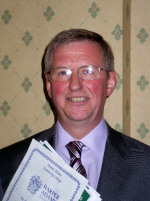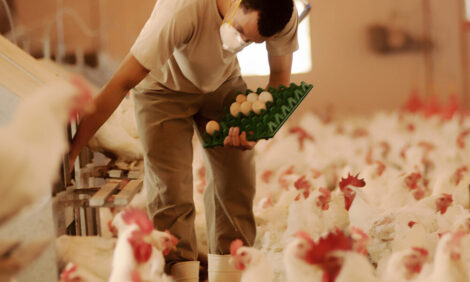



Lessons Learned from an AI Outbreak
The full impact of the 2007 outbreak of H5N1 highly pathogenic avian influenza (HPAI), at a farm belonging to the country's leading turkey company, has been published in a report by Jeremy Hall of Bernard Matthews, reports Jackie Linden, ThePoultrySiteEditor.
'Living through avian influenza H5N1' is the title of Mr Hall's report, which sought to address the UK industry's preparedness for the disease - areas of practical management that require review and improvement, a review of all the parties involved, lessons learned and a blueprint for the future. Mr Hall presented his report at the 16th Temperton Fellowship in London earlier this month.
Living through the Outbreak
30 January 2007
The first warning signs when turkeys in one house at Bernard Matthews site at Holton in Norfolk in eastern England showed a slight rise in mortality. This triggered a visit from the company's veterinary advisor and the company formed an Avian Flu committee to monitor developments.
31 January
Mortality in the house increased further.
1 February
Birds in the affected house were inspected and described by the veterinarian to be unusually quiet. A further 601 birds died. The state veterinary service (SVS) was contacted to request an immediate inspection and for full blood testing.
2 February
The 'Animal Health Team' veterinary inspectors carried out the blood sampling. A further 1500 mortalities were recorded. All remaining birds in the house - 5700 in total - were culled and loaded into an SVS vehicle. In the evening came a report from the Veterinary Laboratories Agency (VLA) in Weybridge that the blood test appeared to be an AI virus of the H5 type.
3 February
A large media contingent assembled outside the farm at Holton and announced that they had been informed that the H5N1 strain had been confirmed as H5N1. The AI team started putting into actionist plans to cull the 160,000 turkeys on the entire farm.
On the same day, a local disease control centre (LDCC) was set up in the nearby town of Bury St Edmunds. As well as Mr Hall representing Bernard Matthews, the LDCC also included 24 other stakeholders including the police, British Poultry Council, a number of animal health experts and local services - 150 people in total.
Bernard Matthews and the Department of the Environment, Food and Rural Affairs (DEFRA) considered a number of options for culling the entire flock of 160,000 on the Holton farm. For reasons of speed and efficiency, Bernard Matthews proposed that the flock should be culling using its factory-based controlled atmosphere stunning (CAS), also in Holton. The proposal was accepted and culling took just 47 hours - significantly less than the 5 to 15 days projected by DEFRA.
Post-Event Review
A number of issues emerged from this review with regard to:
The most appropriate protective clothing for those handling the birds and other potentially infected material.
Availability of catching crews
Health provision for farm staff and catchers (vaccination and anti-viral drugs).
Effective litter treatment as incineration is very costly.
Clarification of cost-sharing
Biosecurity issues, including the requirement for all farms to be made biosecure at any time, and the storage of bedding materials under cover.
Investigation of the Virus Source
Bernard Matthews and a number of agencies conducted a thorough investigation into the source of the AI virus, looking at handling and traceability procedures in the UK. Of all the meat samples collected by the Food Standards Agency, none tested positive for AI and no trace of the virus was found.
All of the samples of wild bird droppings collected on or around the farm and factory tested negative for the AI virus.
Of the 6,149 sample tested, only those from the affected houses were positive for the virus.
The genetic makeup of the virus found at the Holton farm was extremely close to that in a prior outbreak of HPAI in geese in Hungary. At the time of the outbreak in Holton, Bernard Matthews was importing turkey meat from Hungary. Despite a thorough investigation of the audited source of that meat, no sign of the virus was found there.
Despite rigorous inspection, the source of the infection remains unknown.
One theory regarding the source of infection remains but could not be proved. The Holton virus was also very close to the one found in wild waterfowl in Germany only a few weeks previously in December 2006. Migration patterns from the British Trust for Ornithology suggest that a type of wild duck, the common pochard (Aythya ferina) may have been the direct or indirect source of the AI virus in the Holton turkeys.
Blueprint for the Future
Given the high level of risk associated with AI and the possible broader impact of the virus, both industry and government need to work more closely to minimise the risk and impact of this virus. Collaboration is the key.
* "Collaboration is the key" |
|
Jeremy Hall
|
1. To reduce the risk of future infections within Great Britain
2. To ensure food safety for consumers at all times
Objectives for the Industry
3. Sourcing of raw materials in a global trading situation carries risks of disease transfer. A close knowledge of suppliers and approval conditions need to be maintained.
4. Poultry producers must be aware of any change planned, or taking place across the entire food chain in order to avoid import or use of ingredients from regions at high risk of infection.
5. The levels of fraud in international business must be considered; purchase of consignments of poultry meat from unknown or unaudited sources should be challenged.
6. Trade in day-old poultry and eggs can carry considerable risks of virus transfer and other microbiological threats. Care in approving suppliers is essential to minimise such risks.
7. Most poultry companies audit all suppliers before trading commences and carry out visits annually. This may need increased vigilance in the light of AI. The safest option is to reduce purchases of imported meats where possible.
Objectives for Industry and Government
8. Support for the modernisation of bird housing in Britain and the European Union is required as margins for farmers are too small to allow for renovations.
9. Because of the need for a thorough knowledge of bird migration, financial assistance from the government may be necessary to support bodies involved in this work. In the UK, these are the Royal Society for the Protection of Birds and the British Trust for Ornithology.
10. The open briefings from DEFRA were helpful. More advice and regular updates on migration, viral changes and trends are required. The industry also needs up-to-date and detailed information from EU member states on monitoring and reporting. This will need a step-change in attitudes.
11. Joint industry and DEFRA risk reduction strategies are essential and these need the correct funding in all areas of the United Kingdom.
12. If voluntary codes for recreating biosecure conditions on farms are not adopted by all producers, legislation may be the only option.
13. Compliance is essential with DEFRA codes on essential housing of all birds during an outbreak in designated zones. It may be necessary to impose heavy daily fines or to slaughter unhoused birds.
14. Geese too can be housed with an outdoor run alongside the house and covered in Perspex, as is already used in Poland and Hungary. The covered run could be surrounded by wire netting when enclosure is necessary. At other times, it would give covered external access.
15. DEFRA staff must complete trials on gas and foam/gas killing systems. Ventilation shut-down is an unsatisfactory option. Foam-killing is satisfactory and demonstrations should be carried out throughout the country.
16. The current air exclusion policy above and near to an outbreak of disease is essential. Exclusion zones keep helicopters above about 1000 metres and three kilometres from the outbreak zone. It was recommended that this covers not only farms but also slaughter sites to avoid panic among any birds being held in the plants.
17. The reduction in staffing numbers and veterinarians at regional Animal Health offices is considered unwise as it increases the risk of future failure by government to handle future outbreaks.
18. When risk and responsibility arrangements come into play, it is recommended that those operating effective biosecurity should work under a wider umbrella of protection from DEFRA while those failing to adopt good biosecurity and risk-reduction may find protection on losses from disease is reduced or withdrawn.
Further Reading
| - | Go to our previous news item on this story by clicking here. |
June 2008











